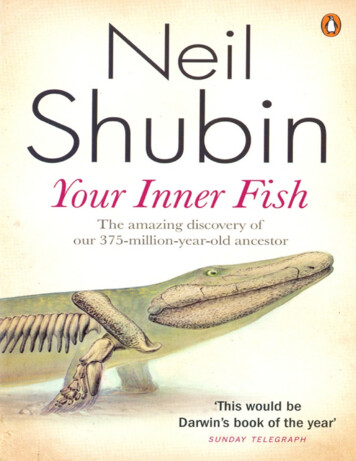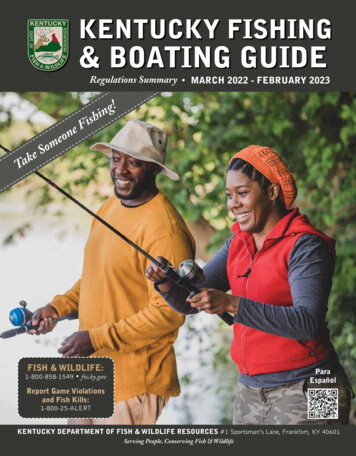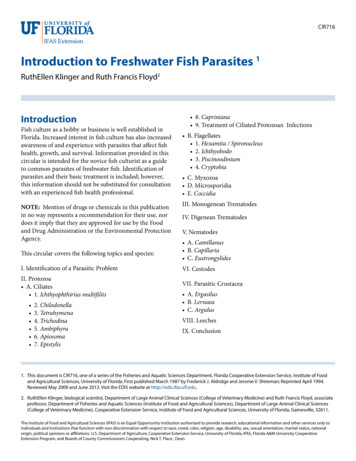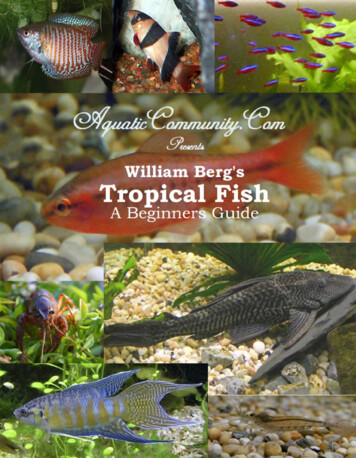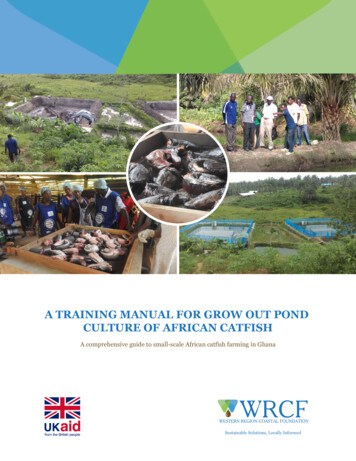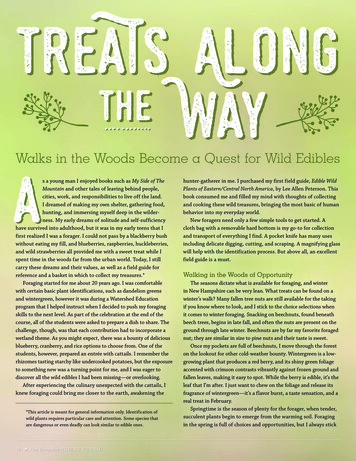
Transcription
treaTs Alongthe WayWalks in the Woods Become a Quest for Wild Edibless a young man I enjoyed books such as My Side of TheMountain and other tales of leaving behind people,cities, work, and responsibilities to live off the land.I dreamed of making my own shelter, gathering food,hunting, and immersing myself deep in the wilderness. My early dreams of solitude and self-sufficiencyhave survived into adulthood, but it was in my early teens that Ifirst realized I was a forager. I could not pass by a blackberry bushwithout eating my fill, and blueberries, raspberries, huckleberries,and wild strawberries all provided me with a sweet treat while Ispent time in the woods far from the urban world. Today, I stillcarry these dreams and their values, as well as a field guide forreference and a basket in which to collect my treasures.*Foraging started for me about 20 years ago. I was comfortablewith certain basic plant identifications, such as dandelion greensand wintergreen, however it was during a Watershed Educationprogram that I helped instruct when I decided to push my foragingskills to the next level. As part of the celebration at the end of thecourse, all of the students were asked to prepare a dish to share. Thechallenge, though, was that each contribution had to incorporate awetland theme. As you might expect, there was a bounty of deliciousblueberry, cranberry, and rice options to choose from. One of thestudents, however, prepared an entrée with cattails. I remember therhizomes tasting starchy like undercooked potatoes, but the exposureto something new was a turning point for me, and I was eager todiscover all the wild edibles I had been missing—or overlooking.After experiencing the culinary unexpected with the cattails, Iknew foraging could bring me closer to the earth, awakening the*This article is meant for general information only. Identification ofwild plants requires particular care and attention. Some species thatare dangerous or even deadly can look similar to edible ones.16nnHampshire WILDLIFENew HampshireWILDLIFE JOURNALJOURNALhunter-gatherer in me. I purchased my first field guide, Edible WildPlants of Eastern/Central North America, by Lee Allen Peterson. Thisbook consumed me and filled my mind with thoughts of collectingand cooking these wild treasures, bringing the most basic of humanbehavior into my everyday world.New foragers need only a few simple tools to get started. Acloth bag with a removable hard bottom is my go-to for collectionand transport of everything I find. A pocket knife has many usesincluding delicate digging, cutting, and scraping. A magnifying glasswill help with the identification process. But above all, an excellentfield guide is a must.Walking in the Woods of OpportunityThe seasons dictate what is available for foraging, and winterin New Hampshire can be very lean. What treats can be found on awinter’s walk? Many fallen tree nuts are still available for the takingif you know where to look, and I stick to the choice selections whenit comes to winter foraging. Snacking on beechnuts, found beneathbeech trees, begins in late fall, and often the nuts are present on theground through late winter. Beechnuts are by far my favorite foragednut; they are similar in size to pine nuts and their taste is sweet.Once my pockets are full of beechnuts, I move through the foreston the lookout for other cold-weather bounty. Wintergreen is a lowgrowing plant that produces a red berry, and its shiny green foliageaccented with crimson contrasts vibrantly against frozen ground andfallen leaves, making it easy to spot. While the berry is edible, it’s theleaf that I’m after. I just want to chew on the foliage and release itsfragrance of wintergreen—it’s a flavor burst, a taste sensation, and areal treat in February.Springtime is the season of plenty for the forager, when tender,succulent plants begin to emerge from the warming soil. Foragingin the spring is full of choices and opportunities, but I always stick
BYMARKBEAUCHESNE ROGER IRWINwith the most select offerings. One of the true highlights of springis ramps (wild leeks), which I discovered while turkey hunting.Wild leeks grow in rich, moist soils, and the sweet onion and garlicnotes make this an extremely versatile plant. Wild leeks are easy toharvest — just pull up the plant, roots and all. A quick rinse in thecreek and they are carefully placed into my forager’s bag.Noontime ends the spring turkey hunt which means it’s time togo fishing. I set up on one of the banks of the Connecticut River withthe hope of landing a walleye, but I am equally motivated to hunt fora storied wild edible. The rich, sandy soils of the Connecticut Riverare home to my favorite spring treat: fiddleheads! Many types offerns grow in the Granite State and most of them have a fiddleheadshape when they first emerge. This is another instance where yourfield guide becomes your most trusted partner in the woods to ensureproper identification because some ferns are toxic.The only fern for me is the ostrich fern. Watch for their frondsthroughout the year which look like a single ostrich feather growingout of a mound. This mound is where the fiddlehead will sproutfrom in the spring. Select tightly curled fiddled heads ranging insize from one inch to three inches in diameter. Their thin, brownpaper-like membrane is another key to their identification. Ialways take care to leave half of any discovered mound unpicked.I want to be able to come back the next year to harvest the sameplants. Harvested fiddleheads should be thoroughly washed, andwhile they can be eaten raw, it is best to cook fiddleheads to 160degrees to avoid potential food-borne illnesses. Flavor profilesare unique and run from “green bean-like” to “asparagus-esque.”Spring’s bounty continues to present itself in the forests.Wood sorrel is common in New Hampshire, and I walked byit for years until I learned I could eat it. This short-growing,parsley-like leaf plant has a bitter kick, but when pairedwith Indian cucumber you can enjoy a flavor-balancedMarch / April 2019n17
hand salad. Indian cucumber is a tuberfound scattered in the moist woods, andI only harvest it where it is plentiful. Thetuberous root is located just below thesurface and is crisp and sweet. This samehand salad combination gets an upgrade inJuly when low-bush blueberries ripen intoseason. Other springtime treats includecowslips, dandelion greens, wild lettuce,and even the invasive Japanese knotweed.All of these, except for the wild lettuce,require some careful preparation techniques such as cooking methods, harvesttiming, and differentiating the non-toxicparts of plants before eating.The Sweet and Savory Days ofSummerSummertime foraging revolves aroundthe fruits of the woods and waters. Iremember sitting in the neck-deep grassbeside my grandparents’ farm looking forthe sweetness of June — wild strawberriesno bigger than a dime. These are the onlystrawberries I will eat. The wild ones are trueto their origin and are of superior flavor. Iwould collect about two cups of these sweetgems to share with my grandmother. Now Ithink of her every time I find a new patch.We are blessed with both highbush andlowbush blueberries in New Hampshire.Their flavor is pure and they are free for thepicking. The highbush variety likes to havewet feet, and just about every lake or pondin the state is lined with highbush opportunities. I prefer to pick the highbush’s berriesfrom the water, and my kayak and a towel areall I need. Paddle up to, and into, the bushand pick away, dropping the berries onto thetowel for safe keeping in the kayak’s hull.Growing in the same area as the highbushblueberries are huckleberries. Though theylook like blueberries, huckleberries are deeperin color and do not grow in clusters — morelike singles on a stem. Huckleberries have astronger and earthier flavor than blueberries,and larger seeds, which I find a treat.Summer continues to sweeten as thelarger berries ripen. Red raspberries arecommon throughout New Hampshireand will produce both a summer and a fallcrop. The lesser known bramble, the blackraspberry, will stop me in my tracks — theflavor of these gems is just like black raspberry ice cream or old school Razzles candy.Black raspberries are a favorite addition to asummer cocktail, as are my favorite bramble,blackberries. This fruit marks the end of thesummer, and these plump sweet berries arewell worth a pricker stick or two.One of the last of the summer’s offerings is wild carrot, which is yet anotherone of those plants I walked past for years.Commonly known as Queen Anne’s lace,this spindly looking plant with its largewhite cluster of flowers hides a sweet treatbeneath the soil. And wild carrot grows justabout anywhere: road sides, ditches, andovergrown fields. Select the roots of firstyear plants and steam them as you wouldgarden carrots.Fall foraging centers on the fungus,and this is where I advise you to invest ina field guide and a class for identificationmastery. There are several choice mushroomspecies that thrive in New Hampshire andharvesting and preparing them is foragingat its highest level. However, there are somehazardous species that look like ediblevarieties so always use caution and do notconsume any wild edible unless you arecertain in their identification.In many instances, modern humans nolonger have the stomach for wild edibles.For too long we have consumed overlycultivated, manicured, commercially grownfoods. I think it’s time we all try to get backinto nature more, and enjoy a snack or twoalong the way.Mark Beauchesne, the Advertising andPromotions Coordinator for the Fishand Game Department, grew up in NewHampshire and has been fishing, hunting, androaming the woods since he was a kid.Sauteed Fiddleheadsllll18Thoroughly rinse 6 cups (1 ½ pounds) of raw fiddleheadsand drain excess water. Rub away papery membranes.Preheat a 14-inch skillet on medium high. Add 2 tablespoonsof olive oil. Once the oil is hot, add the fiddleheads. Sprinklewith two pinches of kosher salt and 4 grinds of black pepper.Cook for 5 minutes stirring often. You want to fully sautéthem.Once the fiddleheads soften and uncurl, turn down the heatto medium. Add 3 tablespoons of quality balsamic vinegar.Reduce the vinegar for another 4-5 minutes.Serve hot. If there are leftovers, the fiddleheads go greatin a quiche. A good sharp cheese will complement thebalsamic vinegar flavor.lMakes 4 to 6 servings.nNew Hampshire WILDLIFE JOURNAL JULIE DESHAIES / iSTOCKPHOTO.COMl
GERRY LEMMOIf you have aninterest in foragingfor wild edibles, putin the time to learnplant identificationand invest in acomprehensive LISA BALLARD LISA BALLARDfield guide. Positiveidentificationis a must andchecking with alocal specialistfor consultation isrecommended.wild strawberries l lowbush blueberries l black huckleberrieslindian cucumber l ramps l wintergreen l ostrich fernfiddlehead l wild carrot l dandelion.CC-BY-SA-2.0 ROGER IRWIN DOUG4537 / iSTOCKPHOTO.COM LISA BALLARD ROGER IRWINlMarch / April 2019n19JILL LEEl JOSH FECTEAU / JOSH FECTEAU.COMClockwise from top left: beech nuts l blackberries l raspberries
l wild strawberries l lowbush blueberries l black huckleberries l indian cucumber l ramps l wintergreen l ostrich fern l fiddlehead l wild carrot l dandelion. If you have an interest in foraging for wild edibles, put in the time to learn plant identification and invest in a comprehensi
